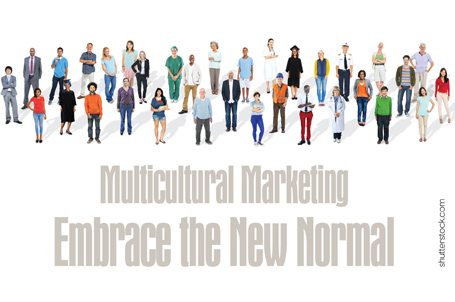The face of the American population is changing. It is time for pharma marketers to embrace the new normal. Minorities now account for over one-third (39%) of the total U.S. population, and by 2030, nearly half (45%) of the population will be multicultural. Within this growing market, U.S. Hispanics represent the largest segment at over 59 million or 18% of total population. Looking to the future, the Hispanic population will grow by +11% over the next five years compared to just +2% for non-Hispanics. For adults 50+, the growth is even stronger with Hispanics growing by +25% in the next five years compared to +6% for non-Hispanics.
Beyond population growth, U.S. Hispanics are increasing in their economic power and access to care. In 2017, Hispanic disposable income is estimated at over $1.5 trillion, which is more than the entire GDP of Russia, Australia, Mexico, or Spain. Additionally, in 2016 Hispanics contributed $32 billion to the total prescription market, a +6% increase versus the previous year. When it comes to healthcare access, Hispanic health insurance rates have reached a new benchmark—84% of Hispanics have health insurance compared to 93% of non-Hispanics.
Prevalence of Chronic Conditions
However, the Hispanic market represents a largely untapped opportunity for healthcare marketers. They have a high prevalence of chronic conditions including obesity, diabetes, cardiovascular diseases, and hepatitis C, and are at least at parity for many other therapeutic areas such as rheumatoid arthritis. In major regions, Hispanics represent the majority of patients for key medical conditions with 47% of diagnosed diabetics in Los Angeles and 67% in San Antonio.
According to Pharmaceutical Research and Manufacturers of America (PhRMA) DTC advertising encourages patient engagement and appropriate use of medicines. Yet, pharma companies don’t reach out to Hispanic patients who are looking for health solutions and want the best care for themselves and their families. To successfully engage Hispanics, marketers must understand Hispanic attitudes and behaviors when it comes to managing their health. Recognizing how cultural characteristics such as collectivism, caregiving, respect for authority, and power distance impact Hispanic health behaviors can help pharma companies more effectively engage Hispanic patients and drive better health outcomes.
Key considerations for reaching out to the Hispanic patient include:
Engage Proactive Patients
Univision and Nielsen’s recent Hispanic Healthcare Journey study indicates that Hispanics value health as a top life priority and are proactive in managing their health. Hispanic patients are more likely than non-Hispanics to actively seek health information (64% versus 58%) and look for new ways to gather information (64% versus 47%). This behavior becomes even more pronounced among patients diagnosed with chronic conditions such as diabetes, high cholesterol, and COPD. For instance, 91% of Hispanic COPD patients actively seek health information compared to 56% of non-Hispanic patients.
As Hispanics are mobile savvy—80% are mobile phone Internet users—and when looking for health solutions, it makes sense that 41% of Hispanics use mobile apps to manage their health compared to 29% of non-Hispanics. As another example, 85% of Hispanics with high cholesterol use the Internet to search for information about their condition compared to 73% of non-Hispanics.
However, there are significantly less resources and information available focused on the Hispanic population. So, although Hispanics are proactive in looking for information, they still feel overwhelmed when it comes to making healthcare decisions and not in complete control of their health. Marketers have an opportunity to help empower Hispanic patients by creating culturally relevant, insight driven outreach.
Acknowledge the Need to Raise Disease Awareness
Looking at the type of information patients are pursuing, the top priorities focus on treatment, managing their conditions, and understanding the impact of their conditions to their overall health for both Hispanics and non-Hispanics. However, Hispanics are more likely to search for the cause of their condition, suggesting lower awareness of disease risk factors. This presents marketers with an opportunity to educate Hispanic patients on the risk factors and symptoms of chronic conditions to increase early screening and diagnosis.
Using type 2 diabetes as an example—a disease that impacts approximately 23% of Hispanic adults versus an approximate 11% of non-Hispanic whites—a knowledge gap exists between Hispanic and non-Hispanic patients. Hispanic patients reflect a lower awareness of the main associated risk factors including family history (78% versus 88%), obesity (72% versus 86%), and lack of exercise (39% versus 57%). Similarly, there is low recognition of early diabetes symptoms among Hispanic patients. Half of Hispanic diabetes patients delayed getting diagnosed because they thought their symptoms would eventually go away compared to only 36% of non-Hispanics.
Once Hispanic patients have been diagnosed, they become highly engaged in their treatment. In fact, patient level data shows that diagnosed Hispanic diabetic patients have a higher treatment rate (66% versus 59%) and stay on therapy longer than non-Hispanics, representing a longer potential lifetime value to pharma brands.
Leverage the Power of DTC
DTC advertising has a significant influence on Hispanic patients. For instance, 36% of Hispanics get their healthcare information from television ads versus only 19% of non-Hispanics. According to Nielsen, Hispanics are an engaged audience—90% of Univision’s audience watches live TV and 94% watch commercials. Consequently, it’s not surprising that Hispanics find prescription ads informative (64% versus 41% of non-Hispanics). Hispanic patients are at least twice as likely to take action, such as speaking to their healthcare providers, based on DTC ads.
Unfortunately, there has been a historical lack of healthcare information and outreach in Hispanics’ language of choice—Spanish. A limited number of brands are reaching out to Hispanics via Spanish-language media. In 2016, 12 times more prescription brands advertised in English-language television compared to Spanish. This means that Spanish-language media offers a less cluttered environment for pharma messaging as well as first mover advantage across many therapeutic areas.
Recognize that Culture and Language Influence Behavior
Cultural attributes lead to nuanced behaviors among Hispanics, and understanding these key nuances can make a significant difference in improving health outcomes. For example, Hispanic patients typically make healthcare decisions as a family unit with the entire collective assuming responsibility for managing care. Pharma companies can leverage this knowledge by creating informational resources for patients as well as caregivers, and incorporating images of families in their promotional materials to enhance patients’ self-identification.
“Power distance” is another example of a cultural characteristic that impacts Hispanics’ health behavior. Hispanic patients view healthcare providers as authority figures and are less likely to question them for fear of seeming disrespectful. This is important for pharma companies to acknowledge, as they have an opportunity to provide Hispanics with discussion guides for their HCP interactions to ensure that Hispanic patients fully comprehend all communications. Understanding these cultural influences—and how they can be leveraged to provide motivational encouragement and impact behavior—is critical for creating outreach that resonates with Hispanic patients.
Not only is it important to engage with this segment in culture, but marketers must also consider communicating in their language of choice. The importance of Spanish is clear given that 83% of Hispanic adults speak Spanish, with 28% speaking only Spanish and 55% being bilingual. IHS Economics forecasts that from 2014-2019, the number of Hispanics who speak Spanish will increase by +13%, and from 2019 to 2024 it will increase by another +11%.
When it comes to health, there is a strong preference for Spanish among all Hispanic patients, including bilinguals. Sixty-two percent of Hispanics prefer resources that allow them to receive information in Spanish if they want, and 58% prefer to have a healthcare provider that speaks Spanish. Spanish is key for ensuring message comprehension as 48% feel that information gets lost in translation if they engage their healthcare provider only in English. This is important to keep in mind as pharma companies develop educational materials for providers, patients, and caregivers.
The preference for Spanish also holds true for DTC messaging. Fifty-seven percent of Hispanics find it easier to understand ads for prescription medications when they are in Spanish. Furthermore, 59% of Hispanics agree that ads in Spanish are more likely to capture their attention, and 52% have a more favorable opinion of a brand that advertises in Spanish. Including Spanish-language outreach in pharma marketing efforts can help brands create a deeper connection with Hispanic patients.
Realize Your Opportunity
U.S. Hispanics are a growing, dynamic, and yet underserved market that needs more focus from pharma companies. Pharma marketers have the responsibility and opportunity to reach these patients to help improve health outcomes and impact their bottom line. Creating culturally relevant outreach is key to impacting Hispanic healthcare behaviors. Given the increasing influence and size of the Hispanic population, the time to engage this market is now.
Resources:
1. U.S. Census Bureau, 2017 & 2021 National Population Projections. Released December 2014.
2. IHS Global Insights 2015
3. Symphony Health MAT Dec 2015 vs. 2016; A18+ Ethnically Identified
4. U.S. Census Current Population Survey ASEC March 2016
5. Centers for Disease Control and Prevention – National Vital Statistics Reports, Vol. 65 No. 4, June 30, 2016
6. Optum Insights 2015 APLD Custom Study Based on Insured A19+: Diabetes Market – ICD-9 50.**
7. PhrMA – 2016 ChartPacks, Chapter 3: Direct-to-Consumer Advertising
8. Univision/Nielsen Hispanic Healthcare Journey Study 2016
9. Nielsen Total Audience Report: Q1 2016. Rel. June 2016. Nielsen Comparable Metrics Report: Q1 2016 Rel July 2016
10. JAMA – Prevalence and Trends in Diabetes Among Adults in the USA 1988 – 2012; September 2015
11. Nielsen, NPM (05/09/16-05/15/16) M-Su 6a-6a, A18-49, 6+ mins. qualifier, news/news documentary, L+7.
12. Nielsen, NPM (12 /28/15-12/25/16) M-Sa 8p-11p/Su 7p-11p, A18-49, excludes sports, PSAs and promos, C3.
13. Nielsen AdIntel 2016 Network TV, Cable TV, and Spot TV
14. Nielsen, 2017 Television Universe Estimates. Based on Language Spoken by the Person in the Home (Hispanic Adults 18+)
15. IHS Economics. Hispanic Immigration and U.S. Economic Growth, February 2015.









